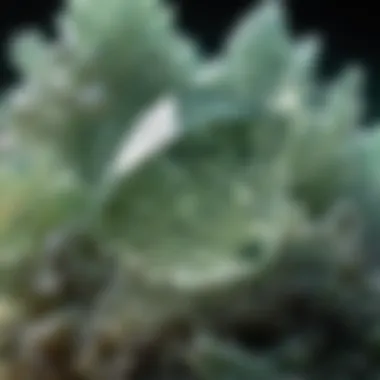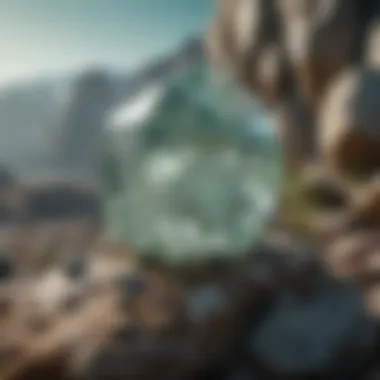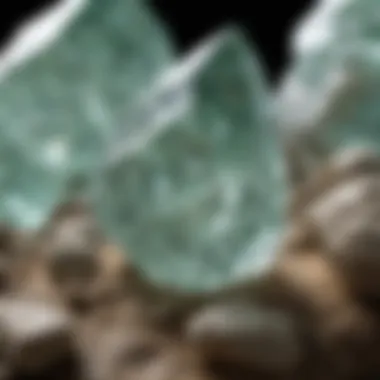Unveiling the Enchanting Allure of Pale Green Crystal: A Comprehensive Guide for Rock and Fossil Collectors


Rock and Fossil Identification
Pale green crystals are a fascinating subject for rock and fossil collectors, offering a unique and enchanting allure in the world of geological treasures. When it comes to identifying these exquisite specimens, there are several key factors to consider. Understanding the types of rocks and fossils that can exhibit pale green crystal formations is essential. Look for specific characteristics such as color, transparency, crystal structure, and any accompanying minerals. Utilizing tools like magnifying lenses, UV lights, and hardness testing kits can aid in accurate identification.
Collecting Tips and Techniques
For aspiring rock and fossil collectors intrigued by pale green crystals, knowing the best practices can enhance the collecting experience. Discovering prime collecting sites where these stunning specimens can be found is crucial. Researching geological maps, visiting mineral shows, and joining local rockhounding clubs can help in locating these sites. When extracting specimens, it's important to prioritize safety by using appropriate tools like rock hammers, chisels, and safety goggles to avoid accidents.
Preservation and Display
Once collectors have acquired their pale green crystal specimens, understanding preservation techniques is paramount to maintain their beauty and integrity. Methods such as cleaning with a soft brush or mild soap and water, and storing in acid-free paper or padded boxes can help preserve these treasures for years to come. When it comes to displaying these geological wonders, consider creative ideas like arranging them in shadow boxes, using LED lighting for illumination, or incorporating them into unique jewelry pieces.
Geological Insights
Delving deeper into the geological aspects of pale green crystals opens a new realm of understanding for collectors. Exploring the formations and processes that lead to the creation of these crystals provides insight into the Earth's intricate processes. The historical significance of certain rocks and fossils can also offer a glimpse into the past, highlighting the evolution of landscapes and life forms. Notable discoveries in the field, both past and present, showcase the ongoing exploration and fascination with pale green crystals.
Introduction
Pale green crystal is a mesmerizing subject that intrigues rock and fossil collectors worldwide. This comprehensive guide aims to unravel the mysteries surrounding these alluring geological specimens. By delving into the formation, properties, and significance of pale green crystals, enthusiasts at all levels can enhance their understanding and appreciation of these precious gems.
Understanding Pale Green Crystal
Definition and Characteristics
At the core of pale green crystal lies a distinctive hue that sets it apart from other minerals. Its ethereal color, reminiscent of fresh foliage, draws collectors due to its rarity and beauty. Understanding the definition and characteristics of pale green crystal is pivotal in recognizing its value and uniqueness within the world of geological wonders.
Common Varieties
Exploring the various common varieties of pale green crystal unveils a spectrum of shades and patterns. Each variant showcases its appeal through subtle differences in color intensity, clarity, and composition. Collectors are sure to appreciate the diverse range of options available, allowing for a nuanced and enriching collecting experience.
Significance in Geology
The significance of pale green crystal in geology lies in its role as a marker of specific mineral formations and geological processes. Geologists value these crystals for their insightful clues about past environments and conditions. Understanding the geological importance of pale green crystals adds depth to the study of both rocks and fossils.
Historical Significance
Ancient Beliefs and Uses


Throughout history, pale green crystals have held symbolic significance in various cultures. Their believed healing properties and spiritual connections have made them prized possessions among ancient civilizations. Unveiling the ancient beliefs and uses associated with these crystals sheds light on the rich tapestry of human history and beliefs.
Cultural References
In art, literature, and religious practices, pale green crystals have left a lasting imprint on cultural references. Their presence in myths, rituals, and adornments signifies a deep-rooted appreciation for their intrinsic beauty and mystical allure. Exploring the cultural references tied to these crystals offers a captivating journey through time and imagination.
Formation and Properties
Pale green crystals hold a significant place in the realm of geology and mineralogy. The formation process and properties of these crystals offer a fascinating insight into Earth's natural processes. Understanding the geological formation of pale green crystals provides valuable information on the conditions under which they develop, offering clues about the environment and time periods in which they were formed. By examining the crystal structure, mineral composition, and formation process, collectors can gain a deeper appreciation for the unique properties and origins of these exquisite specimens.
Geological Formation
Crystal Structure
The crystal structure of pale green crystals plays a vital role in determining their physical and chemical properties. The intricate arrangement of atoms in the crystal lattice affects the crystal's overall symmetry and clarity. The crystal structure influences the crystal's durability and transparency, making it essential for collectors to recognize these patterns for identification and classification purposes. Moreover, understanding the crystal structure aids in assessing the crystal's stability, aiding in its preservation and display.
Mineral Composition
The mineral composition of pale green crystals varies widely, contributing to their distinct characteristics and color variations. The presence of specific minerals influences the crystal's hardness, cleavage properties, and overall aesthetic appeal. By exploring the mineral composition, collectors can appreciate the unique elements that define each crystal specimen, enhancing their value and rarity in the market.
Formation Process
The formation process of pale green crystals involves a combination of geological events and chemical reactions over vast time scales. Factors such as temperature, pressure, and mineral solutions play a crucial role in shaping the crystal's properties. Studying the formation process provides insights into the Earth's geological history, highlighting the dynamic processes that create these mesmerizing geological treasures.
Physical and Chemical Properties
Color Variations
Pale green crystals exhibit a spectrum of color variations, from soft pastel hues to vibrant shades of green. The color intensity is influenced by trace elements present during crystal formation, creating unique patterns and visual appeal. Understanding the significance of color variations helps collectors identify rare specimens and appreciate the beauty of these natural wonders.
Hardness and Cleavage
The hardness and cleavage of pale green crystals determine their durability and susceptibility to breakage. Assessing the crystal's hardness aids in differentiating between similar minerals and evaluating their quality. Understanding the cleavage properties provides valuable information for handling and storing crystals to prevent damage and preserve their natural beauty.
Luster and Transparency
The luster and transparency of pale green crystals contribute to their overall elegance and visual allure. The crystal's luster reflects its light-reflecting properties, enhancing its brightness and sheen. Transparency levels range from opaque to transparent, affecting the crystal's visual clarity and ability to transmit light. By appreciating the variations in luster and transparency, collectors can discern the quality and value of each crystal specimen.
Identification and Classification


In the realm of rock and fossil collecting, the significance of identifying and classifying pale green crystal cannot be understated. This crucial aspect forms the backbone of understanding the distinct features and characteristics that define each specimen. By delving into the visual cues and specialized identification techniques, collectors can accurately categorize these mesmerizing geological treasures. Through mineralogical classification and crystal system analysis, enthusiasts gain a deeper insight into the intricate compositions and structures of pale green crystals, enhancing their appreciation and knowledge base.
Distinctive Features
Visual Characteristics
Visual characteristics play a pivotal role in differentiating pale green crystals from other minerals. The vivid hues and subtle sheen set them apart, attracting collectors with their alluring aesthetics. The translucent quality of the crystals allows light to penetrate, creating a mesmerizing glow that captivates the beholder. Their unique color variations and crystal formations offer a visual feast for enthusiasts, making them highly sought after in collections.
Identification Techniques
Identification techniques serve as essential tools for rock and fossil collectors to authenticate and classify pale green crystals accurately. By leveraging specialized equipment and scientific methods, enthusiasts can analyze the physical and chemical properties of each specimen. Utilizing specialized tests such as hardness and cleavage assessments enables collectors to distinguish genuine crystals from imitations, ensuring the integrity of their collections.
Taxonomy and Classification
Mineralogical Classification
Mineralogical classification plays a pivotal role in categorizing pale green crystals based on their mineral composition and structural characteristics. By examining the unique chemical makeup and crystal lattice arrangements, collectors can assign each specimen to its rightful place in the mineral kingdom. This systematic approach enhances the clarity and precision of classification, offering a comprehensive understanding of the geological origins and properties of pale green crystals.
Crystal System
The crystal system provides a standardized framework for classifying pale green crystals according to their geometric properties and symmetry elements. By categorizing crystals into distinct systems such as cubic or hexagonal, collectors can discern patterns in their physical attributes and crystal habits. This classification system facilitates communication among enthusiasts, ensuring accurate identification and analysis of pale green crystals within the scientific community.
Significance in Collecting
Pale green crystals hold a significant place in the world of rock and fossil collecting, attracting enthusiasts with their enchanting allure and unique properties. Enthusiasts value pale green crystals for their rarity, aesthetic appeal, and geological significance. These geological treasures serve as valuable additions to any collection, offering insights into the Earth's history and mineral formations. Understanding the significance of pale green crystals in collecting allows enthusiasts to appreciate the beauty and intrinsic value of these exquisite specimens.
Rare Finds and Value
Coveted Specimens
Coveted specimens of pale green crystals are highly sought after in the collecting world due to their exceptional beauty and scarcity. These unique specimens often display vivid hues of pale green, captivating collectors with their mesmerizing color variations. The rarity of these specimens adds to their allure, making them highly desirable among collectors seeking exclusive and stunning additions to their collections. Coveted specimens of pale green crystals possess an inherent elegance that sets them apart from common mineral specimens, elevating their value and desirability among collectors.
Market Trends
The market trends surrounding pale green crystals reflect the growing interest in these exquisite geological treasures. Collectors and enthusiasts alike are increasingly recognizing the value and beauty of pale green crystals, leading to a surge in demand for high-quality specimens. As market trends continue to evolve, collectors may observe fluctuations in the availability and pricing of pale green crystals, influenced by factors such as rarity, provenance, and aesthetic qualities. Understanding market trends is essential for collectors looking to acquire or trade pale green crystal specimens, ensuring informed decision-making and successful transactions.
Preservation and Display
Storage Recommendations


Effective storage recommendations play a crucial role in preserving the quality and luster of pale green crystal specimens. Collectors are advised to store their specimens in a cool, dry environment away from direct sunlight and moisture to prevent damage and discoloration. Utilizing protective cases or display boxes can safeguard specimens from dust and physical harm, ensuring long-term preservation and optimal presentation. Proper storage techniques maintain the integrity of pale green crystals, allowing collectors to admire and showcase their specimens with pride.
Display Techniques
Display techniques are paramount in showcasing the beauty and uniqueness of pale green crystals to their full potential. Collectors can enhance the visual impact of their specimens by utilizing strategic lighting, backgrounds, and positioning to highlight key features and characteristics. Incorporating aesthetic elements such as stands, labels, and complementary minerals can create visually appealing displays that capture the essence of pale green crystals. Consideration of display techniques enhances the viewing experience for collectors and viewers, elevating the appreciation and value of these exquisite geological treasures.
Exploration and Collection
Pale green crystals hold a mystical allure for rock and fossil collectors, making the Exploration and Collection section of this comprehensive guide a crucial component. Enthusiasts are eager to delve into the depths of fieldwork strategies and tools of the trade that facilitate their quest for these mesmerizing geological wonders. Understanding the significance of ethical considerations ensures the sustainability and legality of pale green crystal collecting practices.
Collecting Techniques
Fieldwork Strategies
Fieldwork strategies play a vital role in the successful collection of pale green crystals. These strategies involve meticulous planning, keen observation, and strategic decision-making to locate prime sites for crystal discovery. The key characteristic of fieldwork strategies lies in their ability to enhance the efficiency and effectiveness of the collection process. As collectors navigate challenging terrains and harsh conditions, employing appropriate fieldwork strategies increases the likelihood of unearthing rare and valuable specimens. While challenging, fieldwork strategies offer the thrill of discovery and the satisfaction of uncovering hidden treasures.
Tools of the Trade
Utilizing the right tools is essential for rock and fossil collectors seeking pale green crystals. Tools of the trade such as hammers, chisels, magnifying glasses, and geological maps aid in the identification and extraction of crystals from their natural surroundings. The key characteristic of these tools lies in their ability to enhance precision and safety during the collection process. By harnessing the power of specialized tools, collectors can carefully extract crystals without causing damage and ensure a seamless collection experience. While these tools require skill and expertise to wield effectively, their role in the collection process is indispensable.
Ethical Considerations
While the allure of pale green crystals beckons collectors, ethical considerations must underpin every aspect of the exploration and collection process. Sustainable practices are paramount to preserving the fragile ecosystems where these crystals are found. Collectors must prioritize responsible harvesting methods, minimize environmental impact, and contribute to the long-term conservation of crystal habitats.
Sustainable Practices
Adopting sustainable practices is essential in safeguarding the future availability of pale green crystals. By adhering to ethical harvesting guidelines, collectors support ecosystem integrity and promote biodiversity conservation. The key characteristic of sustainable practices is their focus on maintaining ecological balance while fulfilling collectors' passion for crystal exploration. Through sustainable practices, collectors contribute to the longevity of crystal habitats and ensure that future generations can continue to appreciate these geological wonders.
Legal Regulations
Navigating legal regulations is imperative for rock and fossil collectors engaging in the exploration and collection of pale green crystals. Understanding the legal landscape surrounding crystal collecting is essential to avoid legal repercussions and protect both the environment and the collectors themselves. The key characteristic of legal regulations lies in their role in establishing boundaries and guidelines that govern the responsible collection and trade of pale green crystals. While compliance with legal regulations may pose challenges, it is essential for upholding ethical standards and promoting a sustainable approach to crystal collection.
Conclusion
The Conclusion section of this comprehensive guide holds paramount significance as it encapsulates the essence of the entire discourse on pale green crystals. Here, we summarize the key insights uncovered, shedding light on the mesmerizing world of these geological treasures. By delving into their formation, properties, significance in collecting, along with exploration and ethical considerations, we unveil a holistic perspective that resonates with both novice and seasoned rock and fossil collectors. In essence, the Conclusion serves as a compass, guiding enthusiasts towards a deeper appreciation and understanding of pale green crystals.
Appreciating the Beauty
Aesthetic Appeal
The Aesthetic Appeal of pale green crystals is a crucial aspect that mesmerizes collectors and enthusiasts alike. The delicate hues and intricate patterns of these crystals evoke a sense of wonder and fascination. Their soothing tones of green symbolize tranquility and renewal, making them a popular choice among collectors seeking a connection with nature's serene beauty. The unique feature of Aesthetic Appeal lies in its ability to captivate the viewer's gaze, offering a moment of respite amidst the chaos of everyday life. While some may argue that its subtle coloration might be overshadowed by more vibrant specimens, the understated elegance of pale green crystals remains a timeless and refined choice for collectors seeking understated sophistication.
Intrinsic Value
The Intrinsic Value of pale green crystals transcends mere monetary worth, delving into a realm of emotional and spiritual significance. Beyond their external beauty, these crystals hold a deep-rooted value ingrained in their geological formation and the passage of time. Collectors cherish these specimens not just for their rarity or aesthetics but for the stories they tell and the journey they represent. The key characteristic of Intrinsic Value lies in its ability to evoke a sense of wonder and connection to the Earth's history, making each crystal a treasure trove of reminiscences. While some may argue that attaching sentimental value detracts from the objective worth of a crystal, the emotional resonance and personal attachment fostered by Intrinsic Value create a richer collecting experience, elevating each piece to a symbol of profound significance within the collector's repertoire.







